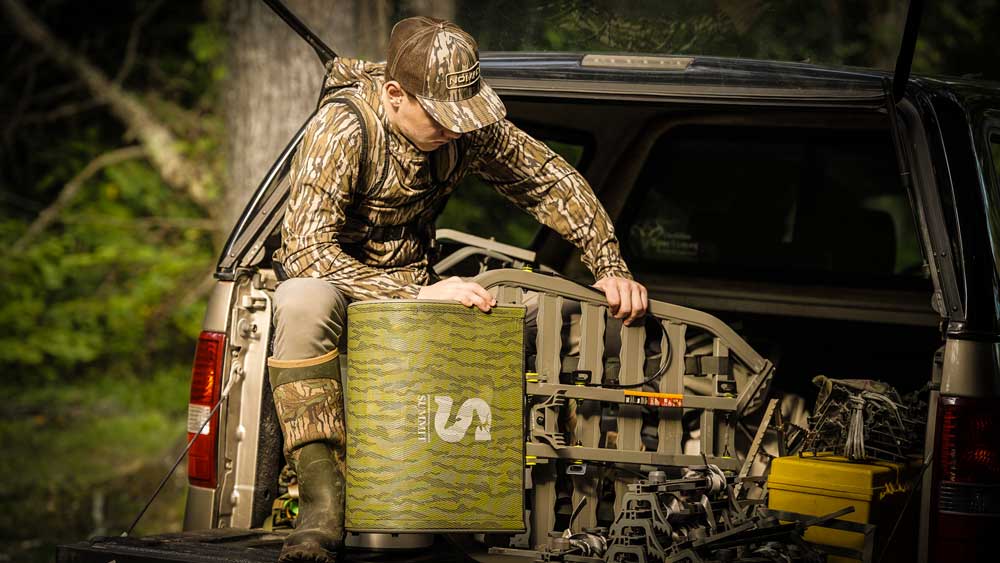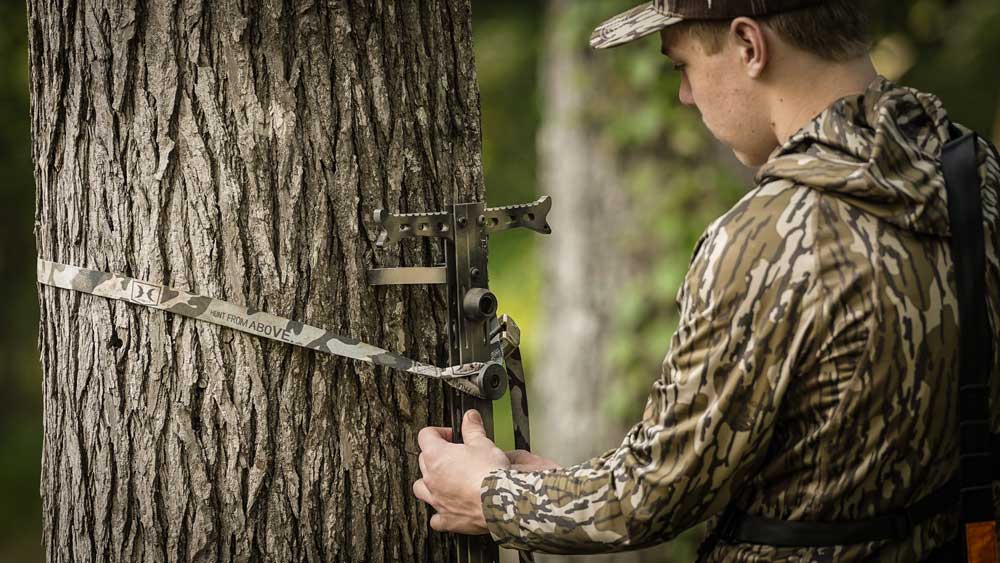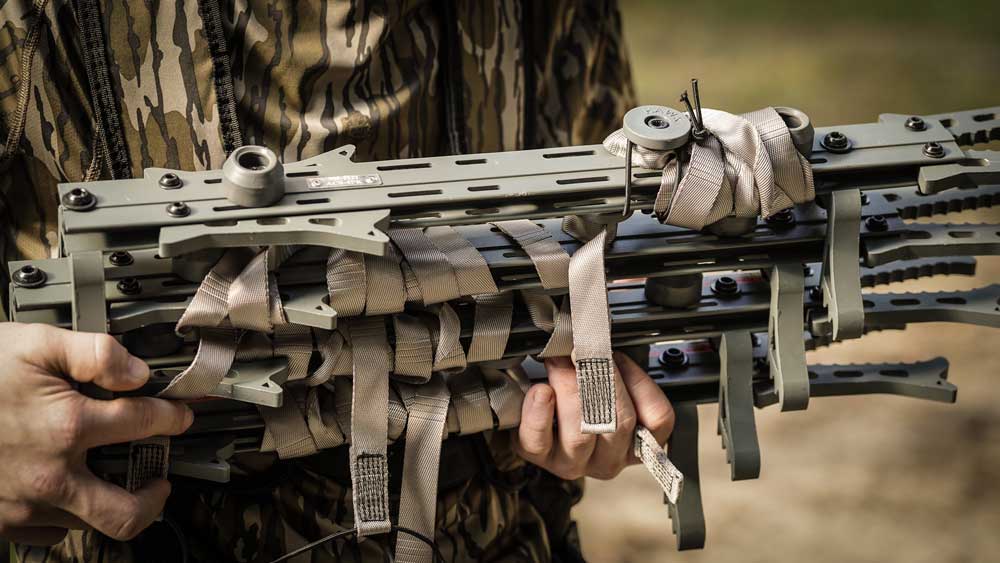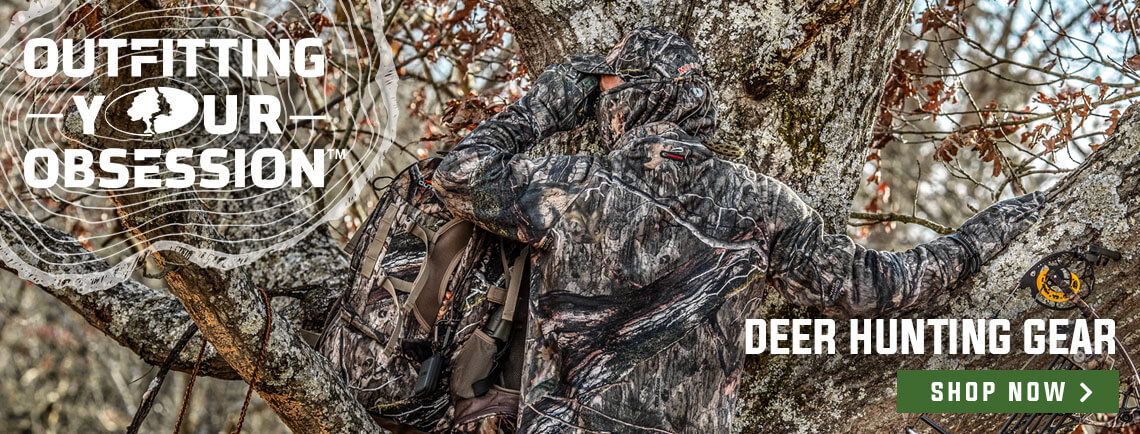Brodie Swisher

"Just hang on tight, and keep climbing."
Those were the words my buddy said to me as he sent me up the tree ahead of him at one of his tree stand locations several decades ago. He already had screw-in steps in place for the first 25 feet up the giant oak tree. My long-legged friend had purposefully spaced the steps much too far apart to deter other hunters from climbing into his stand. It was more than my legs could reach. I had to use a pull and lunge technique to hop from step to step. The massive tree was way too big to reach around to hang on for a solid grasp. I was left to grasp at the sides of the tree with my fingertips.
Twenty-five feet up the tree, I came to the first limb. It was a welcomed moment to finally have something solid to hug on to after the risky climb to that point. However, the moment didn’t last long. There were more steps to climb and more limbs to monkey around. Another 11 feet up, and I finally came to the tree stand. I was sweating and shaking when I finally turned to sit down in the tree stand. I had been up to some pretty lengthy heights while hunting from a tree stand over the years, but none as sketchy of a tree as the one I now found myself in.
There we were, 36 feet up the tree. No harness, no life-line and no regard for how easily our neglect of safety gear could have resulted in serious injury or death. I spent most every minute of that hunt dreading the climb back down.
That was many years ago. Nobody really used a safety belt at that time. Hunter Safety System wasn’t a thing, and the idea of using a life-line was pretty much unheard of. However, things have changed. There’s no excuse for not being safe when climbing in and out of the tree stand these days. With deer seasons opening up across the country, here’s a look at the top tips for tree stand safety to ensure you always make it home to your family at the end of the hunt.
Inspect Stands Before the Season
Regardless of whether your tree stands are stored in the garage or already hanging in the woods, it’s important to give them a thorough inspection prior to use. It doesn’t matter what shape they were in last year when you used them last. Things can change in the off-season. Squirrels, mice, and exposure to the elements can wreak havoc on tree stands and the straps that secure them. Look them over from top to bottom. Check cables, bolts, and all the welding joints.
I was teaching a hunter education class some years ago and was preparing to step onto a climbing tree stand for the tree stand safety portion of the class when I looked down and noticed a broken weld on one of the platform’s main support bracing. The stand was just a year old. It was a good example that even the best tree stand brands in the business can fail. Never hang a stand, or climb into one, without inspecting it first.
Replace Tree Stand Straps Often
As mentioned above, tree stand and climbing stick straps can be damaged by rodents, as well as weather and exposure to sun. They become brittle and can break under pressure after years of use - even when they look like they are in good shape, holding the stand/stick solid and secure.
Most tree stand accidents seem to happen from a stand that “appeared” safe and secure. A good practice is to replace the straps on your tree stand and ladder sticks every couple years, regardless of how they look. It can be expensive to replace straps on all your stands and sticks, but the reality is that it’s a cheap investment into the safety of your family or friend climbing in and out of the tree stand.

WATCH: 6 TREE STAND SAFETY TIPS
Wear a Harness
With a number of quality tree stand harness manufacturers on the market today, there’s no excuse for not wearing a harness while hunting from a tree stand. Don’t want to spend $100 on a tree stand harness? No problem. You’ll find a free fall restraint device with every tree stand you purchase these days. Again, there’s no excuse for not using it.
Sure, it’s not the most comfortable thing to have to deal with. And yes, it adds more gear to keep up with or load down in your pack. But the harness should be considered non-negotiable. Figure out some other gear to trim from your arsenal. Don’t let the tree stand harness be an item you head to the woods without.
Use a Life-line
Wearing a tree stand harness is a great way to eliminate the risk of a fall once you’re in the tree stand. However, statistics show that 86% of tree stand accidents actually occur when climbing in and out of the tree stand. The transition from the ladder sticks to the stand, or stand to the sticks at the end of the hunt, are where things can go south in a hurry. And regardless of whether you’re wearing a harness or not, there is no protection from a fall here. That is, unless you’re using a life-line device.
The life-line is a rope with one end attached to the tree above your tree stand. The rope travels down the side of the tree, with the other end tied off at the base of the tree. A prusik knot and carabiner slide along this rope, allowing you to be safely anchored as you climb. There’s never a moment you’re not anchored to this fall restraint device. It’s the absolute safest way to hunt from a tree stand. It should be standard equipment for every fixed-position tree stand.

Avoid Excessive Heights
As mentioned above, we used to climb to some ridiculous tree stand heights years ago. The older I’ve gotten, the closer I tend to stay to the ground. My 25’-30’ tree stand climbs have turned into 15’-25’ climbs over the years. I guess having a wife and kids will do that to a man. I’ve got more to get home to these days than back in my younger years. That’s why I don’t climb excessive heights anymore.
Sure, climbing to extreme heights can help you get out of the eyesight of deer, but there’s also a lot of issues that come into play when hunting high above the ground. The added height is enough to make most hunters a little edgy. The focus can easily shift from notching kill tags to worrying about falling from a stand, or executing a quality shot from extreme tree stand heights. I learned over the years that I’m more accurate when it comes to shooting my bow at lower heights. Those extreme shot angles can be tough, even with a deer standing at 15 yards.
Hunting closer to the ground can be safer, more comfortable, and offer the hunter much better shooting opportunities. Look for good cover in the tree that’ll allow you to blend in, wear quality camo, and you’ll disappear, even from lower tree stand heights.
Final Thoughts
It’s been said that it’s not a matter of if, but when, you’ll fall from a tree stand. It can happen to anyone, as evidenced by the fall veteran hunter Terry Drury took several years ago while attempting to climb into his tree stand. Drury has about as much tree stand experience as any hunter out there.
Wearing a safety harness is much like wearing a seatbelt in the car. It can be an annoying hassle. But when you need it, you really need it badly. Tree stand safety equipment is the stuff you hope you’ll never need. But again, it’s insurance. When your time comes, you’ll be glad you paid the price to stay protected.
































